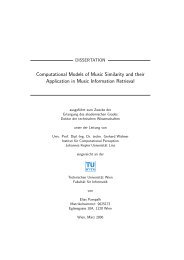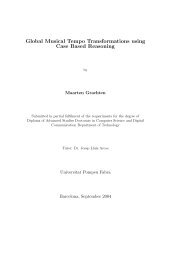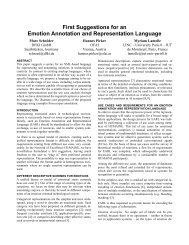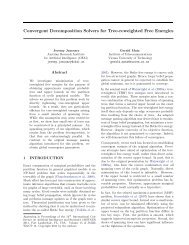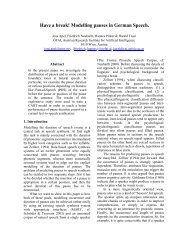A HYBRID MODEL OF REASONING BY ANALOGY
A HYBRID MODEL OF REASONING BY ANALOGY
A HYBRID MODEL OF REASONING BY ANALOGY
Create successful ePaper yourself
Turn your PDF publications into a flip-book with our unique Google optimized e-Paper software.
The best mapping is found by evaluating all possible ones in parallel on a competitive basis. This is<br />
done by relaxing the constraint satisfaction network (the LTM extended with the temporarily<br />
constructed nodes and links) using the associative mechanism. Because of the links between the<br />
elements of the target and source descriptions and the correspondence nodes, the activity of all<br />
nodes in LTM influences the activity of the correspondence nodes. What makes this different from<br />
the use of the associative mechanism in the automatic retrieval process is the presence of inhibitory<br />
links in the network. After relaxing the network, we find the best mapping in the following way:<br />
for each slot in the target the most active correspondence node is found (which is the winner on the<br />
basis of the competitive mechanism of relaxing the network) and the link between the map node<br />
and that corresponding node is strengthened to have a weight of 1, while all other competing links<br />
are dropped out. In this way the map node is finally connected only to these correspondence nodes<br />
which form the best mapping.<br />
The relaxing mechanism does not start at any particular moment, because, as it has been pointed<br />
out, the associative mechanism runs continuously, and in this way in each moment its partial<br />
results are available, i.e. at each moment, independently how much semantic or structural<br />
correspondence is established, the first approximation of a best map is present.<br />
Manipulating Input and Goals .<br />
One way of pragmatic control of processing is goal manipulation, i.e. putting forward additional<br />
goals or subgoals (like direct mapping between most active slots) or rejecting some old goals.<br />
Another way of pragmatic control of processing is changing the input nodes. If, for example,<br />
something in the environment is changed then the perceptual mechanism will change the state of<br />
the input nodes (including the case where another reasoner provides some help by drawing<br />
attention to some elements of the target or by presenting additional information). But it is also<br />
possible to consider an active reasoner that may for example re-read a written description of the<br />
current problem which would focus her attention on some particular details, or the reasoner might<br />
perform actions that change the environment and perceive their effects, or she can write down<br />
intermediate results of the reasoning process and then read them back (by redirecting the input<br />
activity), or she can manipulate the environment itself by experimenting and testing certain<br />
hypotheses.<br />
Pragmatic control on the running of processes within mapping .<br />
The mapping process is performed by all those symbolic processes running in parallel. The exact<br />
moment when a symbolic processor is triggered, and both its speed and success heavily depend on<br />
the activity of the node representing this process and on the activity of the nodes which are used as<br />
data by this process. In this way a thorough pragmatic control is established on the way the<br />
mapping process is performed.<br />
Processes of establishing semantic and structural correspondence compete with each other running<br />
in parallel at different speed, and thus at each moment both establishing semantic correspondence<br />
between additional elements and establishing structural correspondence by developing the<br />
connectionist network further (i.e. building new correspondence nodes and links based upon the<br />
existing ones) can continue.<br />
Depending on the results of this competition (i.e. which one will be most active) either more<br />
concrete or more abstract analogies can be reached. Of course, this competition can be partially<br />
influenced by the reasoner by manipulating the input and goal nodes. For example, if a goal to find<br />
an abstract mapping is established, the concept `abstract' and the related concepts (like `object',<br />
`relation', `cause') will be activated. This will enable the semantic process to find general<br />
correspondences (e.g. `John' and `table' being both objects, a property that would not ordinarily




